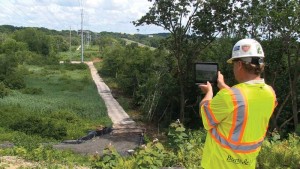 Improving infrastructure is vital to safety, sustainability and economic growth in the U.S. For those routing transmission lines, communication begins in the earliest stages — developing strong relationships with community stakeholders and the general public. Especially on projects involving land acquisition, these relationships are fundamental throughout the process, from the start of planning to long after construction begins.
Improving infrastructure is vital to safety, sustainability and economic growth in the U.S. For those routing transmission lines, communication begins in the earliest stages — developing strong relationships with community stakeholders and the general public. Especially on projects involving land acquisition, these relationships are fundamental throughout the process, from the start of planning to long after construction begins.
With a comprehensive public engagement plan, utilities can seek input from stakeholders and the public on multiple issues. This feedback helps create positive project solutions, minimize inconveniences during construction and leads to a more successful overall project.
Inviting Community Input
A robust public outreach strategy creates a clearly defined process for landowners to engage and equips utilities with a defensible position that demonstrates due diligence has been completed to satisfy community concerns. On transmission line routing projects, the public is increasingly attuned to and actively involved in addressing issues that affect their communities, so it’s smart to be prepared to handle a significant public response — and to include interested parties in the process.
Public involvement goes beyond press releases and open houses. It is designed to engage the diversity of stakeholders early and often with information they understand and give them an opportunity to be heard.
Burns & McDonnell has helped utilities explain complex projects by developing communication pieces with language that’s easy for landowners and community members to understand. Additionally, frequent opportunities for engagement invite input at each stage, allowing utilities to demonstrate that they are listening by incorporating feedback into the decision-making process. This transparency helps utilities stay in front of public opinion.
A Proactive Approach to Public Engagement
It comes down to a simple philosophy: Be proactive rather than reactive. Don’t let the fear of sharing with the community keep you from engaging. By working to understand what community stakeholders are saying, utilities can plan thorough routing considerations, which becomes a defensible route.
While most utilities understand why a comprehensive communication plan is important, they often don’t have the necessary resources to execute. That’s where our stakeholder management specialists come in. Our team is able to support a utility’s public relations staff with responsive project input and positive stakeholder experiences.
It helps to understand the process from every angle. We build transmission routing plans with a high level of detail and attention. We apply that same commitment to the public engagement plan. Experience on both sides of the effort enhances the result.
I recently led a lively discussion on community engagement plans at the annual International Right of Way Association conference in San Diego. I’d be happy to recap the conversation if you’d like to hear more; just let me know. Have you seen community engagement (or lack thereof) make a difference on a routing project? I’d love to hear about it in the comments.
Joab Ortiz heads Burns & McDonnell’s Stakeholder Management Solutions Department. He works with clients across the country to develop strategies that engage stakeholders, including public officials, community leaders, special interest groups, landowners and the public. Connect with Joab on LinkedIn.
